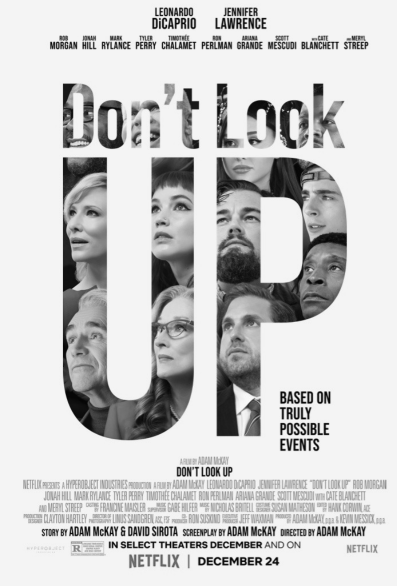Adam McKay’s new satire flick, “Don’t Look Up,” released in theaters December 5th and on Netflix December 24th. It is about a true story that hasn’t happened yet.
Not only does “Don’t Look Up” comically advise on how not to approach future catastrophe, it also holds up a mirror to our current reality. The film does a spectacular job at recreating this reality — whether it be the politicization of science, distrust of media, government’s obliviousness to their responsibility or lobbyists affecting policy.
The movie’s plot is driven by the doomsday countdown clock to when an asteroid will hit the Earth. Two astronomers, Dr. Randall Mindy and PhD candidate Kate Dibiasky — played by Leonardo DiCaprio and Jennifer Lawerence, respectively — discover the asteroid, named Comet Dibiasky. The scientists are forced to deal with the ramifications of their findings and warn the world while being thrust into a political hellscape.
McKay said the idea for the film came from “a burgeoning terror” of the climate crisis. He noted how the lack of climate coverage and amount of climate denial is both “horrifying” and “preposterously funny.” Cate Blanchett and Tyler Perry play TV hosts for a show similar to Good Morning America called The Daily Rip. McKay uses The Daily Rip to showcase how mainstream media treats climate coverage.
When the astronomers first appear on the show, they do so directly after a segment on a celebrity proposal between Kid Cudi’s and Ariana Grande’s characters. The scientists’ credibility is undermined by the hosts as they crack jokes like, “Is this asteroid going to hit my ex-wife’s house?” In response to the insincerity of the hosts, Dibiasky blows a gasket. Her passionate and enraged tantrum over the hosts not taking the asteroid seriously became a viral meme…
McKay’s message is clear: the media focuses too much on trivial things and society encourages it by making a joke out of everything.
Three other characters: President Orlean, Jason Orlean and Peter Isherwell further represent the sources of McKay’s frustration and serve as major opponents to the astronomers who are trying to warn the world of the impending armageddon.
Academy award-winning Meryl Streep plays the self-absorbed President Orlean who is an amalgamation of presidents: Nixon, Clinton and Trump, to name a few. The president’s son, chief of staff and unofficial hype man, is played by ever-comedic Jonah Hill who is determined to bolster his mother’s political image at all costs — even if the price is the destruction of the planet.
The president and her son decide that it is best to “sit tight and assess” rather than provoke another political crisis — she focuses only on the fallout of her unpopular and unqualified Supreme Court nominee.
McKay uses Orlean’s response to critique the brokenness of American politics today. Similarly to how Orlean does not want to immediately confront the asteroid, politicians are hesitant to propose or enact policy so as to not lose support and risk losing control during such partisan times.
Eventually, leadership seems to be working when Orlean gives the orders to use nuclear warheads to redirect the asteroid. But at the last moment, she exits the Situation Room at the behest of Bash CEO Peter Isherwell played by Mark Rylance and calls off the mission. Isherwell wants to mine the asteroid for rare metals rather than stopping it in its tracks.
The monotone Isherwell is a caricature of tech bro billionaires like Jeff Bezos and Elon Musk, and serves as a stand-in for capitalistic greed. McKay has Isherwell abruptly swoop in and interrupt a cheery moment to strongly emphasize the power companies and their lobbyists hold over politicians and their decisions, policies and impact.
The obstacles Dr. Mindy and Dibiasky attempt to overcome while warning the world of the direness of the asteroid are parallel to the struggles of climate scientists and virologists today.
Amy Mainzer, the science advisor on the movie, ensured the science was factual and that the way characters talked, looked and interacted with their environments were realistic.
Everything from the monitor readouts in the observatory to the departments involved like the Planetary Defense Coordination Office to asteroid deflection is in the vein of what would happen if such a discovery were made.
Mainzer, who worked at NASA as a project scientist and has an asteroid named after her (as does the fictional Dibiasky) commented on the most realistic part of science the film addressed — the scientists’ frustration as they try to communicate and intervene in bad policy. Mainzer said, “Whether it is the pandemic or climate change, we can provide our findings, but at some point the scientists are not the ones with the power to make the decisions.”
There might be hope on the horizon for more direct scientific communication between scientists and the government. Recently, NASA’s new chief scientist Kathern Calvin, made it clear that climate change would be a key to her vision for NASA. As Calvin told CNBC, “NASA is already a world leader in climate. And so I’m just communicating that science and connecting it to other agencies, to the public.”
Optimistic endeavors such as what Calvin’s statement and NASA’s Double Asteroid Redirection Test (DART) offer may make Don’t Look Up seem more like fiction rather than a true story that hasn’t happened. But the ending to the film, which is antithetical to a storybook ending, is an urgent warning for what will happen if we don’t set pettifoggery behind.






